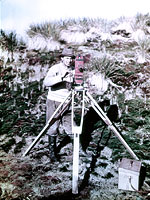
 Frank
Hurley was the photographer on the British Imperial Trans-Antarctic Expedition,
1914–1917, under Sir Ernest Shackleton.
Frank
Hurley was the photographer on the British Imperial Trans-Antarctic Expedition,
1914–1917, under Sir Ernest Shackleton.
At age forty-seven, Alfred Cheetham was the most experienced crew member, having spent six years in Antarctic waters, including time as boatswain on Terra Nova, during Scott’s ill-fated attempt to reach the South Pole.
After the Endurance became trapped in sea ice in January 1915, Hurley took many photographs of the ship until it was crushed and sank ten months later.
Reaching down through the icy water then slowly flooding the Endurance, Hurley retrieved his Paget colour plates of the Endurance and its fate. These strangely beautiful and dramatic images were carried by Hurley to safety through the trials of the expedition’s escape from the Antarctic.
The Paget Colour Plate system was marketed from 1913. It used a ruled set of
colour lines, called a screen, sandwiched with a standard black and white glass
half plate negative. The subject was exposed through the colour screen, which
acted like a series of colour filters, onto the black and white negative. The
negative was reverse processed into a positive transparency and placed back in
contact with another screen, giving the effect of a colour photograph.
Display item Trans-Antarctic Expedition
< Previous Exhibit | Back to The Exhibits page | Next Exhibit >